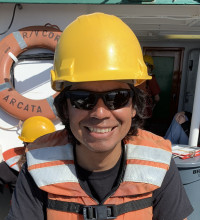Night smelt, Spirinchus starksi, is an ecologically, economically and culturally important forage fish that occurs from Central California to Southeast Alaska. The species is a vital part of regional food webs, a significant prey item for marine mammals, birds and other commercially important fish such as Chinook salmon. In California it is fished commercially, recreationally and for subsistence, primarily in Humboldt and Del Norte counties. However, despite the importance of night smelt, very little is known about its biology and ecology, and there are no criteria to identify when this fishery is overfished or in decline.
This study addressed several key information gaps in night smelt biology and provided managers with valuable tools for future management decision-making. The researchers collected, identified and described larvae using genetic techniques and were able to estimate the abundance, length, weight and age of adult fish, along with environmental parameters. Their findings suggest that Humboldt and Del Norte night smelt are smaller, lighter, younger, and more of them are males than a decade ago. These results suggest that these populations are in decline, potentially due to unfavorable oceanographic conditions that lasted longer than the length of their lives (3-years), and may require stricter regulations such as seasonal or annual closures.
In California, night smelt are managed by the California Department of Fish and Wildlife (CDFW). In this project the researchers collaborated with resource managers and scientists at CDFW, Washington Department of Fish and Wildlife, NOAA Southwest Fisheries Science Center, and multiple Tribes and Tribal networks. Because of this collaboration, all information from this study is immediately available to fisheries managers. The project also included a day-long workshop to exchange information and provide training in sampling and aging, which would allow state agencies and Tribal nations to conduct their own analyses.
 Jose Marin Jarrin
Jose Marin Jarrin